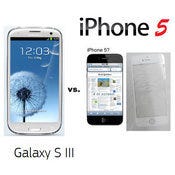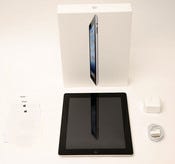Samsung denies charges as day two of infringement trial sees opening statements and first Apple witness.


Apple iPhone 5 Vs. Samsung Galaxy S III: What We Know
Apple iPhone 5 Vs. Samsung Galaxy S III: What We Know (click image for larger view and for slideshow)
Apple asserted in its opening statement of its infringement case against Samsung that the Korean firm analyzed and systematically copied one feature after another of its iPhone and iPad devices, then brought look-alike products to market.
Apple designer Christopher Stringer, the trial's first witness, was asked by lead Apple attorney what he thought as he witnessed competitors bringing phones similar to the iPhone's design to market. "We'd been ripped off. It was plain to see, particularly by Samsung. We were offended," he said.
It was the punchline that Apple had been building toward on a day of opening statements, following Monday's jury selection of seven men and three women in U.S. District Court in San Jose on the opening day of the trial. The courtroom with limited seating was packed with attorneys, journalists, and observers, as was an overflow courtroom where sound and video were piped in.
[ Does anybody benefit from this trial? Apple-Samsung Case Hurts You, Me, The Economy. ]
Samsung lead attorney Charles Verhoeven was soon able to issue a rejoinder to the charges in his own 90-minute opening statement. But before he could launch into it, he felt constrained to remind the jury that they needed "to keep an open mind," that there was "more to the story than what you've just heard." Unlike Verhoeven's presentations, which frequently stopped and started again as he searched for the proper exhibit, Apple's narrative flowed from start to finish with a rising indignation. It moved toward what seemed an inevitable conclusion. Verhoeven seemed to understand its potential impact on a lay jury.
Apple's lead attorney, Harold McElhinny, started out, for example, by showing a simple graphic of six Samsung phones in a wide variety of form factors prior to the launch of the iPhone at Macworld in January 2007. Next to it, he showed Samsung phones being produced by 2010. They all have the rectangular proportions and rounded corners of the iPhone form factor.
McElhinny produced what he called a Samsung design document that compared iPhones, feature by feature, with Samsung's Galaxy model and noted whenever the iPhone's features were different. And the apparent design response in each instance was to "make something like the iPhone."
"To be blunt, Samsung has not been honest about this copying," he said.
Toward the end of his 90 minutes, McElhinny poured special effort into depicting Samsung as, not only an unscrupulous competitor, but so unethical that it failed to live up to its obligation to disclose pending patents to other members of an international standards body, the European Telecommunications Standards Institute (ETSI), as it was required to do.
Samsung was ready, when the time came, to launch its counterattack. Nevertheless, one well dressed, young Samsung executive providing support to the legal staff was undergoing culture shock in the overflow room as he experienced the American legal system firsthand. Samsung for two decades has been a key supplier to Apple. He walked about the room, saying: "We are close business partners. Why are we slinging mud at each other?"
Samsung's Verhoeven, when his turn came, disputed the last assertion first. Samsung has made important contributions to wireless standards and under ETSI rules, confidential, proprietary information did not have to be disclosed during its application for a Korean patent. "Any suggestion otherwise is without merit," he said.
Apple had engaged in selective evidence presentation, he claimed. Yes, Samsung makes phones in a similar slim, rectangular proportion as the iPhone but it has always made a variety of phones and still does. Apple hadn't shown the six models that do not look like the iPhones that Samsung produces, said Verhoeven. In addition, Samsung had designed a phone with rounded corners and a rectangular shape before the iPhone was launched.
Apple holds 200 patents on the design elements of the iPhone, including the specifics of its user interface. It has patented the "bounce back" feature of a document being viewed on an iPhone. When the user reaches the edge of the document, instead of allowing the cursor to continue off into white space, or "getting lost in the desert," as Apple designers term it, it bounces back to the center of the document or top of a list.
Apple patented the finger-guided scrolling on the iPhone screen, and McElhinny made much of the uniqueness of two-finger gesture controls on the iPhone screen, such as the flicking of the thumb and forefinger to prompt an application to zoom in on an object.
But Samsung may have scored points with the jury by disputing Apple's claim to having invented a unique product by illustrating prior uses of finger-controlled scrolling and multiple-finger gestures. Verhoeven showed a photographer manipulating images on a light box by moving them around and prompting them to enlarge through finger gestures, contesting the claim Apple had solely invented the idea.
He cited three prior patents issued in Japan and the U.S. that captured definitions of multiple finger gestures accomplishing image movements similar to those executed on the iPhone. The Nomura patent was issued in Japan in 1998. A U.S. patent captured the ability to zoom in and out on fractal images through a technique labeled "Diamond Touch." Another finger gesture patent that had been demonstrated by Jefferson Han at the TED conference in Monterey, Calif., in 2006 was issued that year.
These constitute prior art that the U.S. Patent Office examiner failed to consider in granting Apple a patent on the finger controls of the iPhone user interface, Verhoeven asserted. "When a patent is granted, it doesn't mean the examiner knows everything. Apple claims it invented finger scrolling and use of the two-finger touch gesture, but there were other inventors," he said.

New iPad Teardown: Inside Apple's Tablet
New iPad Teardown: Inside Apple's Tablet (click image for larger view and for slideshow)
As for the charge that Samsung violated Apple's patent covering the act of enlarging an image by double-touching it, Verhoeven disagreed again. Prior art, or previously invented uses of the practice, exist in both Microsoft and HP products, he said. They weren't the commercial success of the iPhone, but commercial success doesn't entitle Apple to claim that it invented something that it did not, Verhoeven said. "This patent issued to Apple is not valid," he concluded.
Verhoeven didn't deny that Samsung studied and duplicated some features of the iPhone. "Being inspired by a good product is not copying. It's competition, people competing with each other. There's nothing wrong with that," he said.
Samsung is a key supplier to Apple. Twenty-six percent of the iPhone is built using Samsung components, a situation that is expected to continue, regardless of the outcome of the trial. Under an avalanche of charges that Samsung copies rather than innovates on its own, Verhoeven responded that Samsung employs 1,000 of its own designers. It designs both components and its own products. It must be able to innovate on its own, if Apple keeps buying its products for its devices, he asserted.
Apple called the first of what is likely to be many witnesses in the case to buttress its claims. Stringer, an Apple designer for 17 years, took the stand wearing a cream-colored suit that contrasted with his shoulder-length brown hair, goatee, and mustache. Amid all the lawyers' pinstripes, most observers, if asked which individual in the courtroom was the Apple designer, would have been able to pick him out.
On the stand, he showed that he could talk the talk as well. Apple maintains that it has sole rights to iPhone-style (and iPad) designs because the devices are unique, "revolutionary," and the result solely of its own original work. McElhinny sought to elicit from Stringer how Apple came about such creative designs.
After reviewing sketches and CAD drawings of early iPhone ideas, McElhinny asked him how he settled on a particular version. The design process was filled with many false starts and attempts to combine just the right details, he said. "It was the most beautiful of our designs. The world had never seen anything like this."
The design team was released from concerns about manufacturability of the device or combinations of materials. "We came up with some things that were breathtakingly beautiful. ... We had a long list of challenges to overcome to make it work. We were using glass in close proximity to the metal. We were drilling holes in close proximity to the glass. We insisted on this high polish steel band around the product. It was incredibly hard to polish."
The design team opted for a flat surface, with the glass meeting a piece of curved metal around the rim of the face with no overlap and little gap.
Apple lavished similar care on the user interface. "We wanted to make a device that was breathtakingly simple, something very easy to understand, something that you just wanted to pick up and use."
"It felt like an entirely new thing," he concluded.
Under cross examination, Verhoeven asked him if he had seen the similar Samsung designs. Stringer answered that he might have. "Did you see a design with four soft buttons at the bottom," Verhoeven persisted. Stringer answered that he might have, he wasn't sure.
"Did you think it was beautiful?" asked Verhoeven.
"Well," said Stringer, "it didn't stick in my mind."
Android and Apple devices make backup a challenge for IT. Look to smart policy, cloud services, and MDM for answers. Also in the new, all-digital Mobile Device Backup issue of InformationWeek: Take advantage of advances that simplify the process of backing up virtual machines. (Free with registration.)
About the Author(s)
You May Also Like







